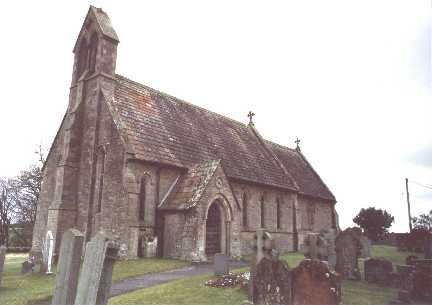 Lies on the south side of the Irthing, between Naworth
and Upper Denton, containing 4530 acres, rated at £2555 8s., and 280 inhabitants,
resident in 59 houses. It includes the small hamlet of Low Row,
where there is a station for the Newcastle and Carlisle Railway, four miles E. of
Brampton. On the low side of the parish the soil is light and sandy, and on the south or
high side, it is stronger, but of a cold and sterile nature. Mr. Housman says vast
quantities of petrified marine shells are found, in a band of limestone, under freestone.
The principal landowners of this parish are the earl of Carlisle, the Rev. Thomas Colbeck,
Thomas Ramshay, Esq., and John Waugh, Esq.; and the former is lord of the manor, which is
part of the barony of Gilsland. The customary tenants pay two years value and a heriot, on
change of tenant, and a fine on the death of the lord. Denton is said to have derived its
name from the Irish Dœn, signifying deep; and the Danes called it their Dæin town, villa
in profundo. The Church, dedicated to St. Cuthbert, is a small humble edifice.
The benefice is a rectory, in the patronage of the bishop of Carlisle, and imcumbency of
the Rev. Thomas Colbeck. It is valued in the king's books at £8 5s. 5d., but was
augmented in 1761 with £200 from queen Anne's bounty, and £200 given by the dowager
countess Gower; and was certified to the ecclesiastical commissioners as of the average
value of £196 per annum. At the enclosure there were about 500 acres allotted, partly in
lieu of tithes and partly by right of common. Robert, son of Bueth, granted the church to
Wetheral priory, and after his death, it was given to that of Lanercost. Denton hall,
now a modern farm house, was anciently the seat of the Dentons, who exchanged it for
Warnel. Part of the old tower is still preserved, and is now used as a dairy: its walls
are eight feet thick.
Lies on the south side of the Irthing, between Naworth
and Upper Denton, containing 4530 acres, rated at £2555 8s., and 280 inhabitants,
resident in 59 houses. It includes the small hamlet of Low Row,
where there is a station for the Newcastle and Carlisle Railway, four miles E. of
Brampton. On the low side of the parish the soil is light and sandy, and on the south or
high side, it is stronger, but of a cold and sterile nature. Mr. Housman says vast
quantities of petrified marine shells are found, in a band of limestone, under freestone.
The principal landowners of this parish are the earl of Carlisle, the Rev. Thomas Colbeck,
Thomas Ramshay, Esq., and John Waugh, Esq.; and the former is lord of the manor, which is
part of the barony of Gilsland. The customary tenants pay two years value and a heriot, on
change of tenant, and a fine on the death of the lord. Denton is said to have derived its
name from the Irish Dœn, signifying deep; and the Danes called it their Dæin town, villa
in profundo. The Church, dedicated to St. Cuthbert, is a small humble edifice.
The benefice is a rectory, in the patronage of the bishop of Carlisle, and imcumbency of
the Rev. Thomas Colbeck. It is valued in the king's books at £8 5s. 5d., but was
augmented in 1761 with £200 from queen Anne's bounty, and £200 given by the dowager
countess Gower; and was certified to the ecclesiastical commissioners as of the average
value of £196 per annum. At the enclosure there were about 500 acres allotted, partly in
lieu of tithes and partly by right of common. Robert, son of Bueth, granted the church to
Wetheral priory, and after his death, it was given to that of Lanercost. Denton hall,
now a modern farm house, was anciently the seat of the Dentons, who exchanged it for
Warnel. Part of the old tower is still preserved, and is now used as a dairy: its walls
are eight feet thick.
Mannix & Whellan, History, Gazetteer and Directory of Cumberland, 1847